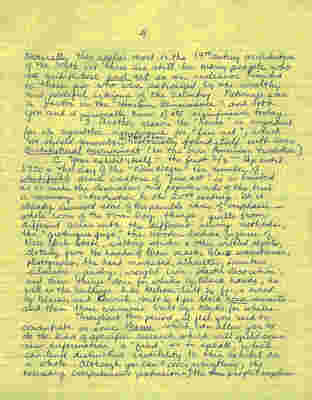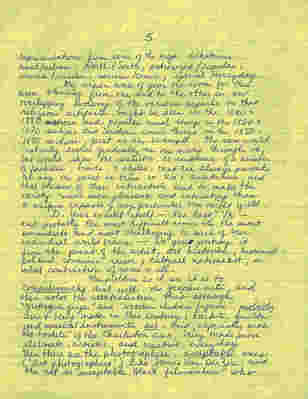Pages
1
11-10-74
David - The miracle has happened - I have written a letter. I do think it's important to enumerate the ideas we spoke of in some sort of form so I guess "I's been inspired."
I. Definition of Parameters A. We must first analyze the L.A. mentality with the insecurity and egocentusm of it's "new money" - clarify their position on what constitutes "fine arts" vis-a-vis the prevailing opinion of the Met in New York vis-a-vis the New York and San Francisco undergrounds (i.e. "environmental art") B. then we need to clarify specifically what your position will be on the "nature of art," especially in regards to the 20th century, when the expansion & multiplicity of personages along with the continuing popular (i.e. "folk") traditions raise some contradictions. It should be very clear in your mind: 1) what aspect of creativity you want to deal with 2) what segment of the population (Black, white, whatever) you want to address yourself to - implicit in this is the notion of "class." 3) What effect you want to have on the groups in question. It boils down to - to what degree will this be a historically educational, asthetically inspiring, and spiritually enlightening presentation for different segments of the Black population. Is your aim to address any or what segment of the white population? C. Development of a strategy to push through your concept past what will obviously be stubborn, opinionated, and (in this area of art) narrow-minded people. this point is particularly important as we both know the appearance of compromise is not necessarily compromise.
2
2.
II. Set-up of the exhibit A. Obviously the parameters of your scope will be directly influenced by time (until information due), financial, and research limitations. there are a limited number of people who would be available and appropriate for such an endeavor, and the money, as you said, is minima. Just as an offhand statement, I would think that September 30, 1975, would be a much better date for submission of your list of sources and items to be utilized as it would allow the addition of the summer for the extensive research which just has to be done if you are to present the "major coups" in thinking on the subject that I think you need to present. (By the way, did we decide what the L.A. museum group expects you to do in terms of quality, innovation, itc.? I'm (so sure?) they don't expect the kind of bang-up job which you hope to do, do they?) B. the "House" - an example of view. Pick up almost any book on the American house from an architectural point of view and inevitably you will find the following: 1. If the author's progressive he'll include a few pages and maybe even a picture of one of the rough hewn early (19th century) one-room cabins that "our pioneering ancestors so bravely began in." Of course he'll not include that this and other versons of the log cabin were not only common but the prevailing mode of "architecture" throughout the 17th, 18th, and, especially on the periphery of the westward expansion, even through to the 20th century. He'll also not mention that the first buildings of the Jamestown, Va. settlement were thatched roofed wattle and daub structures amazingly like the "mud hut" of the African stereotypes.
3
3.
2. If the author is typically traditional he'll begin with the "Federal Period" mansion which though small (i.e. Washington's Mount Vernon) by present Mansion standards will show the building in which the master slept (or was supposed to sleep). He'll then proceed throughout the classic antebellum Southern mansions (done in that same 1840's & 50's boom period which was so fruitful for the (bright ?)-leaf tobacco growers adn Thomas Day in North Carolina and which, by the way, were some 40 years off the pace set by the architectural trend makers of the east coast & New England states, (but ?) then communication was slower) and on through the proliferation of styles relative to urban, industrial, and "robber baron" architecture, the point is that he will not include the barns, outside kitchen cooking spaces, and supportive "out buildings", particulary out-houses, that were basic to the running of any plantation, large or small. He probably also won't include the buildings that most of the population, Black or white, resided in because of his unconscious elitist attitude and personal lack of knowledge, this ponit was best illustrated to me in Charleston, S. C. by herbert deCosta when, as he was telling Jonathan & me of the rennovation he did, he mentioned that only the "big house" was rennovated, and never the servants quarters. Those were either torn down or converted into contemporary apartments. This revelation became increasingly significant when one realizes that the census for the 1840's shows Charleston as one of those cities with a majority Black population (true for over 150 years of its existence) so that this means the city fathers were really eradicating the typical characteristics of the cities architectural history in favor of a superficial representation & perpetuation fo the "myth of the Old South."
4
4.
Naturally this applies most to the 19th century architecture of the South but there are still too many people who see architecture and art as an endeavor limited to those few who were patronized by the wealthy and powerful citizens of the country. Patronage was a factor in the "Harlem Renaissance" and both you and I personally know of its significance today. 3. Another reason the "house" is important for its symbolic significance for "fine art", which we should remember, is that it has historically found itself with some architectual environment (in the Euro-American tradition.) C. Your exhibit itself - the first 2/3 - Up until 1920 & the day of the "New Negro" the number of identifiable Black creators of "fine art" is so limited as to make the decorative and popular arts of the time a necessary introduction to the 20th century. We've already discussed some of the possible items of emphasis _ whole room of the Tom Day things, quilts from different areas with the different sewing methods, the "grotesque jugs," the Wooden Indian figures of New York State, walking sticks & other wittled objects, clothing from the hands of those Master Black seamstresses, photographs, the hand crocheted silhouettes, furniture, silverware, jewelry, wrought iron, plastic decoration, and those things done for whites by Black hands, as well as the buildings like Melrose - built by, for, & owned by Blacks, and Keswisk - built by & for Black "house servants. and then those mansions built by Blacks for whites. Throughout this period, I feel you need to concentrate on some theme which can allow you to do the kind of specific research which will yield some new information, a "find" so to speak, which can lend distinctive credibility to this exhibit as a whole. Although you can't cover everything, the necessary comprehensive pretensions of the project implies
5
5.
representations from some of the major dichotomies: rural/urban, North/South, patronized/popular, sacred/secular, serious/comic, special/everyday. My vision was of your one room for this area blending from one end to the other in an overlapping evolving of the various aspects so that religious artifacts might be seen in the 1840 & 1880 sections and popular rural things in the 1820 & 1870 sections and Southern comic things in the 1850 & 1890 sections, just as an example. The room would not only evolve gradually as one moved through it, but would show the realistic co-existence of a number of fashions, trends, & styles, that are always present, at any one point in time in art & architecture, and that because of their interaction tend to make the variety much more pleasant and interesting than a uniform expanse of any particular one might yield. D. Your exhibit itself - the last 1/3 - and probably the most difficult since it's the most immediate and most challenging to each of our individual world views - Do you portray it from the point of th artist, art hisorian, historical - political conscious raiser, cultural nationalist, or what combination of some or all. The problem as I see it is to comprehensively deal with the graphic arts, and then solve the contradiction that although "grotesque jugs" and "wooden Indian figures" probably aren't being made in this Century, baskets, quilts, and musical instruments are, and, especially with the baskets of the Charleston area, being made more elaborate, artistic, and creative everyday. Then there are the photographers, acceptable ones ("Art photographers") like James Van DerZee, and the not so acceptable Black filmmakers who






